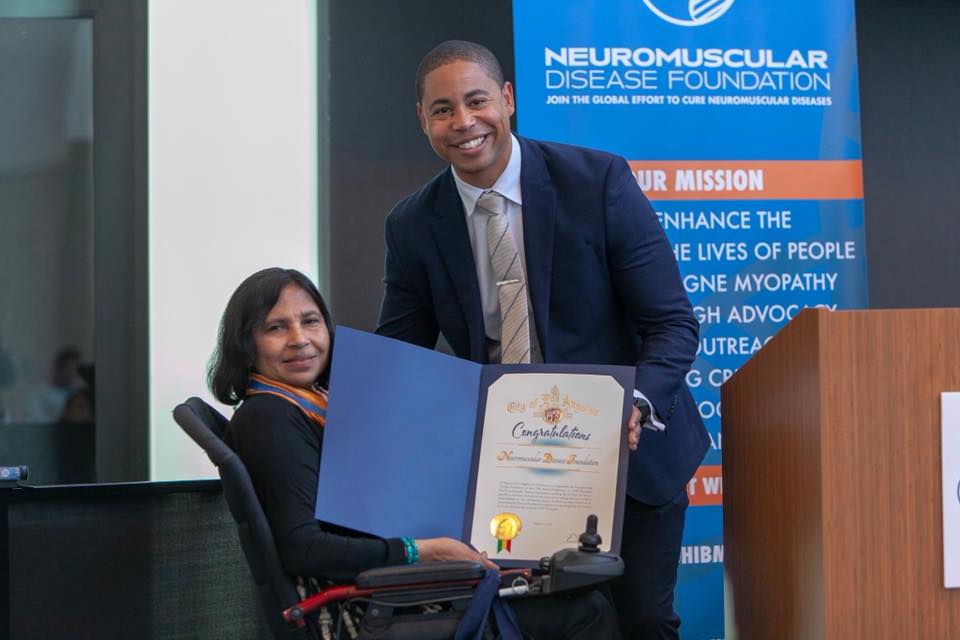Moving Toward 'Next-Generation' Gene Therapy
MDA partnered with a French muscle disease association to host a symposium on advancing gene therapy for neuromuscular diseases
Article Highlights:
- Planning for the next generation of gene and stem cell therapies for muscle diseases is on the minds of scientists seeking to overcome challenges inherent in current “first-generation” approaches.
- MDA partnered with the Association Française Contre Les Myopathies (French Association Against Myopathies) to host a May 16, 2013, symposium at which experts came together to share ideas about how to keep the field moving forward.
- The symposium was held in Salt Lake City in conjunction with the 16th annual meeting of the American Society of Gene & Cell Therapy.
by Amy Madsen on May 23, 2013 - 5:00am
Planning for the next generation of gene and stem cell therapies for muscular dystrophies — even as the first generation is still under development — was the theme of a joint symposium sponsored by MDA and the Association Française Contre les Myopathies (French Association Against Myopathies, or AFM) at the 16th annual meeting of the American Society of Gene & Cell Therapy (ASGCT).
The MDA/AFM symposium was held May 16, 2013, in Salt Lake City, in conjunction with the May 15-18 ASGCT meeting. It was co-chaired by Charles A. Gersbach, an assistant professor at Duke University in Durham, N.C., and Kathryn Wagner a neurologist and neurogeneticist at the Kennedy Krieger Institute in Baltimore. Gersbach’s research includes gene therapy, biomolecular and cellular engineering, regenerative medicine and synthetic biology; Wagner, a longtime and current MDA research grantee, studies muscle regeneration.
Limitations to current muscle gene therapy approaches
Finding effective methods of gene delivery to muscle tissue is one of the main challenges facing the field, noted symposium speaker Jeffrey Chamberlain, professor of neurology, medicine and biochemistry at the University of Washington, Seattle, and a longtime MDA grantee and member of MDA's Scientific Advisory Committee.He explained that current approaches to gene therapy aim to deliver therapeutic genes directly to muscle fibers using the emptied-out shells of adeno-associated viruses (AAV) as delivery vehicles. (This is the approach being used to deliver micro- and mini-dystrophin genes in gene therapy strategies under development for Duchenne muscular dystrophy, or DMD.)
Two problems with AAV delivery are:
- it's unable to accommodate very large genes (like dystrophin); and
- it's not an efficient method for delivering genes to muscle satellite cells, which are muscle-specific stem cells.
New strategies in development
Symposium speakers discussed ideas specific to their own research, as well as more general concepts, including overcoming the delivery challenge.Chamberlain reviewed recent developments in an alternative delivery approach involving a different type virus — a lentivirus — that may prove more effective at delivering genes to satellite cells, which are stem cells that are on their way to becoming muscle.
He noted that satellite cells can be obtained from patients, corrected using genes delivered in a lentiviral vehicle, and then introduced back into the body, where they may serve to permanently repair and replenish abnormal muscle with healthy muscle. Unfortunately, the efficiency of this method, which has been tested in mice, is low, but Chamberlain's lab and other labs are working to improve that.
Molecular geneticist Xiao Xiao, at the University of North Carolina at Chapel Hill, reviewed his lab's recent efforts at overcoming an important hurdle in gene therapy efforts: delivering sufficient numbers of therapeutic genes to all of the muscles that need them.
His lab currently is working on delivering genes to individual limbs by isolating the limb from the rest of the body with a tourniquet, while pumping therapeutic genes (encased in delivery vehicles) into a vein in the isolated limb. Xiao noted that the method has been demonstrated to be safe (using only a saline solution) in humans, and highly effective at gene delivery in large animal models.
At Généthon, a not-for-profit biotherapy lab funded by AFM in Evry, France, research scientist Anna Buj-Bello currently heads a translational program focused on investigating the potential for gene therapy to treat myotubular myopathy (MTM).
Buj-Bello presented updates about a collaboration with Martin Childers on an MDA-AFM-funded project to investigate gene therapy for MTM, in which the team is using a dog research model that has a naturally occurring form of the disease. (The dogs have a mutation in the myotubularin gene.)
Buj-Bello reported that therapeutic myotubularin genes encased in AAV delivery vehicles were delivered to the limbs of MTM dogs. The limbs had been isolated from the rest of the body via the use of a tourniquet. However, in at least one of the dogs, the tourniquet leaked and a systemic therapeutic effect was observed, including dramatically increased life span, and vastly improved muscle and respiratory function.
Fulvio Mavilio, an expert on gene therapy for rare diseases and director of Généthon, presented information about two gene therapy efforts under development for DMD, focusing in particular on an exon-skipping approach that has the potential to persist much longer in the body than exon-skipping strategies currently in testing.
Several current exon-skipping strategies would involve periodic and repeated injections of biological components called U7 splice site modulators. With the new method, genes that carry the instructions for building the modulators are injected (encased in AAV delivery vehicles) instead. Cells are able to use those instructions to synthesize the U7 splice site modulators. Because the replacement genes persist in the body over time, it’s unlikely that repeat treatments would be needed. A clinical trial to test the new method is expected to begin in late 2013 or early 2014.
For more information
To learn more about gene therapy advances, read:- DMD, BMD: Combining Gene Therapy and Stem Cell Transplantation, Quest News Online, March 21, 2013;
- SMA Research Briefs: Gene Therapy, New SMA Mouse, Quest News Online, March 14, 2013;
- DMD: Dystrophin-Deficient Dogs Benefit from Gene Therapy, Quest News Online, Jan. 15, 2013; and
- Podcast Describes Results of LGMD2C Gene Therapy Trial, March 14, 2012.
